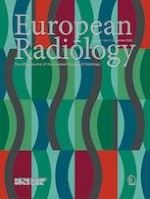01-11-2020 | Fatty Liver | Gastrointestinal
Comparing mono-exponential, bi-exponential, and stretched-exponential diffusion-weighted MR imaging for stratifying non-alcoholic fatty liver disease in a rabbit model
Published in: European Radiology | Issue 11/2020
Login to get accessAbstract
Objectives
To compare diffusion parameters obtained from mono-exponential, bi-exponential, and stretched-exponential diffusion-weighted imaging (DWI) in stratifying non-alcoholic fatty liver disease (NAFLD).
Methods
Thirty-two New Zealand rabbits were fed a high-fat/cholesterol or standard diet to obtain different stages of NAFLD before 12 b-values (0–800 s/mm2) DWI. The apparent diffusion coefficient (ADC) from the mono-exponential model; pure water diffusion (D), pseudo-diffusion (D*), and perfusion fraction (f) from bi-exponential DWI; and distributed diffusion coefficient (DDC) and water molecular diffusion heterogeneity index (α) from stretched-exponential DWI were calculated for hepatic parenchyma. The goodness of fit of the three models was compared. NAFLD severity was pathologically graded as normal, simple steatosis, borderline, and non-alcoholic steatohepatitis (NASH). Spearman rank correlation analysis and receiver operating characteristic curves were used to assess NAFLD severity.
Results
Upon comparison, the goodness of fit chi-square from stretched-exponential fitting (0.077 ± 0.012) was significantly lower than that for the bi-exponential (0.110 ± 0.090) and mono-exponential (0.181 ± 0.131) models (p < 0.05). Seven normal, 8 simple steatosis, 6 borderline, and 11 NASH livers were pathologically confirmed from 32 rabbits. Both α and D increased with increasing NAFLD severity (r = 0.811 and 0.373, respectively; p < 0.05). ADC, f, and DDC decreased as NAFLD severity increased (r = − 0.529, − 0.717, and − 0.541, respectively; p < 0.05). Both α (area under the curve [AUC] = 0.952) and f (AUC = 0.931) had significantly greater AUCs than ADC (AUC = 0.727) in the differentiation of NASH from borderline or less severe groups (p < 0.05).
Conclusions
Stretched-exponential DWI with higher fitting efficiency performed, as well as bi-exponential DWI, better than mono-exponential DWI in the stratification of NAFLD severity.
Key Points
• Stretched-exponential diffusion model fitting was more reliable than the bi-exponential and mono-exponential diffusion models (p = 0.039 and p < 0.001, respectively).
• As NAFLD severity increased, the diffusion heterogeneity index (α) increased, while the perfusion fraction (f) decreased (r = 0.811, − 0.717, p < 0.05).
• Both α and f showed superior NASH diagnostic performance (AUC = 0.952, 0.931) compared with ADC (AUC = 0.727, p < 0.05).





